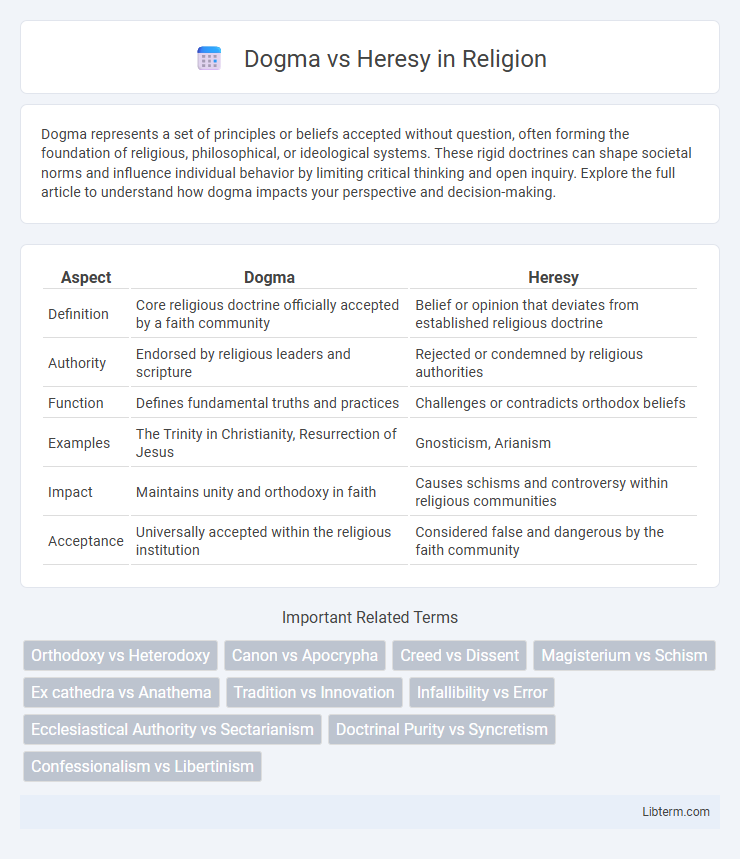Dogma represents a set of principles or beliefs accepted without question, often forming the foundation of religious, philosophical, or ideological systems. These rigid doctrines can shape societal norms and influence individual behavior by limiting critical thinking and open inquiry. Explore the full article to understand how dogma impacts your perspective and decision-making.
Table of Comparison
| Aspect | Dogma | Heresy |
|---|---|---|
| Definition | Core religious doctrine officially accepted by a faith community | Belief or opinion that deviates from established religious doctrine |
| Authority | Endorsed by religious leaders and scripture | Rejected or condemned by religious authorities |
| Function | Defines fundamental truths and practices | Challenges or contradicts orthodox beliefs |
| Examples | The Trinity in Christianity, Resurrection of Jesus | Gnosticism, Arianism |
| Impact | Maintains unity and orthodoxy in faith | Causes schisms and controversy within religious communities |
| Acceptance | Universally accepted within the religious institution | Considered false and dangerous by the faith community |
Understanding Dogma: Definition and Origins
Dogma refers to established beliefs or doctrines proclaimed by a religious authority as incontrovertibly true, forming the foundation of faith and practice. Its origins trace back to early theological councils and writings where core tenets were defined to maintain doctrinal unity and guide followers. Understanding dogma involves recognizing its role in shaping religious identity and distinguishing orthodox teachings from dissenting views or heresy.
The Nature of Heresy: Meaning and Implications
Heresy refers to beliefs or opinions that deviate from established dogma, challenging the core doctrines accepted by a religious community. This deviation often leads to significant theological conflict, social exclusion, and sometimes legal repercussions within religious institutions. The nature of heresy implicates not only spiritual deviation but also the preservation of orthodox faith and communal identity, highlighting the tension between doctrine and dissent.
Historical Context: Dogma and Heresy Through the Ages
Dogma and heresy have shaped religious and cultural history, defining orthodox beliefs and challenging established doctrines since antiquity. Early Church councils, such as Nicaea in 325 AD, solidified Christian dogma by condemning heretical views like Arianism, influencing theological and political power structures. Throughout the Middle Ages, the identification of heresy often served to enforce conformity within Christianity, leading to inquisitions and the suppression of dissenting ideas that threatened ecclesiastical authority.
Key Differences Between Dogma and Heresy
Dogma refers to the established, authoritative beliefs officially accepted by a religious or ideological institution, serving as foundational truths that guide its followers. Heresy represents beliefs or opinions that deviate from or directly contradict these core doctrines, often leading to conflict or condemnation within the community. The key difference lies in dogma's role as an accepted standard of truth, while heresy challenges or rejects these accepted principles.
Authority and Power: Who Defines Dogma?
Authority and power in defining dogma rest primarily with established religious institutions, such as the Vatican or major theological councils, which possess doctrinal authority to interpret sacred texts and establish orthodox beliefs. Heresy is identified when individuals or groups challenge this centralized authority, undermining the official dogma and threatening institutional control. The interplay between dogma and heresy reveals how religious power structures maintain orthodoxy by delineating acceptable beliefs and suppressing dissenting interpretations.
The Role of Heretics in Shaping Belief Systems
Heretics have historically challenged established dogma by introducing alternative interpretations and critiques that provoke theological debates and reforms. Their dissent often prompts religious institutions to clarify, codify, or reinforce core doctrines, thereby shaping the evolution of belief systems. Controversial figures labeled as heretics contribute to theological diversity, indirectly influencing orthodoxy through contested ideas.
Social and Cultural Impacts of Dogma
Dogma shapes social cohesion by providing a unified framework of beliefs that influence cultural identity and community norms. It often acts as a stabilizing force, guiding moral behaviors, rituals, and traditions that reinforce group solidarity. The acceptance of dogma can limit social change by discouraging dissent and promoting conformity within cultural institutions.
Consequences of Challenging Dogma
Challenging dogma often results in social ostracism, loss of credibility, and potential excommunication within religious communities, fundamentally altering one's social and spiritual standing. In historical contexts, dissenters faced severe consequences such as imprisonment, persecution, or even execution, underscoring the gravity of opposing established beliefs. The tension between dogma and heresy continues to influence contemporary religious and ideological debates, shaping the boundaries of acceptable belief and practice.
Modern Perspectives: Dogma and Heresy Today
Modern perspectives on dogma and heresy emphasize the evolving interpretation of religious doctrines in contemporary society. Dogma is viewed as foundational beliefs essential for communal identity, while heresy is increasingly seen as dissent that challenges institutional authority and prompts theological development. This dynamic reflects broader cultural shifts toward pluralism and critical inquiry in faith traditions.
Navigating Belief: Open Inquiry vs. Orthodoxy
Navigating belief involves balancing dogma, which enshrines established doctrines, and heresy, often seen as deviation from orthodoxy. Open inquiry fosters critical thinking and reinterpretation of spiritual truths, contrasting with rigid adherence to dogma that limits theological evolution. Understanding this dynamic is essential for religious discourse, allowing faith traditions to adapt while maintaining core principles.
Dogma Infographic

 libterm.com
libterm.com